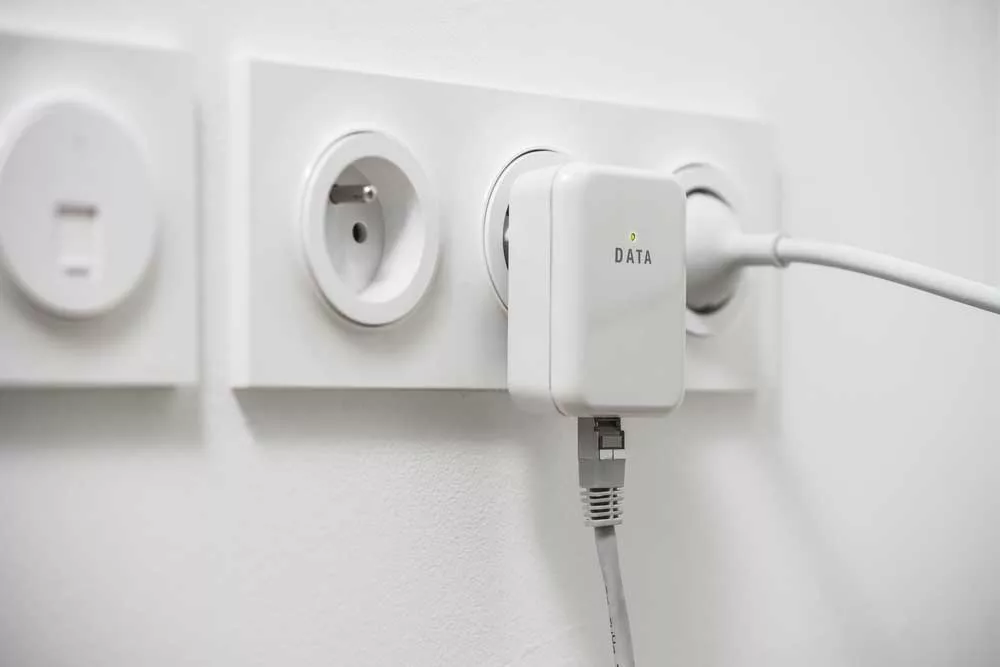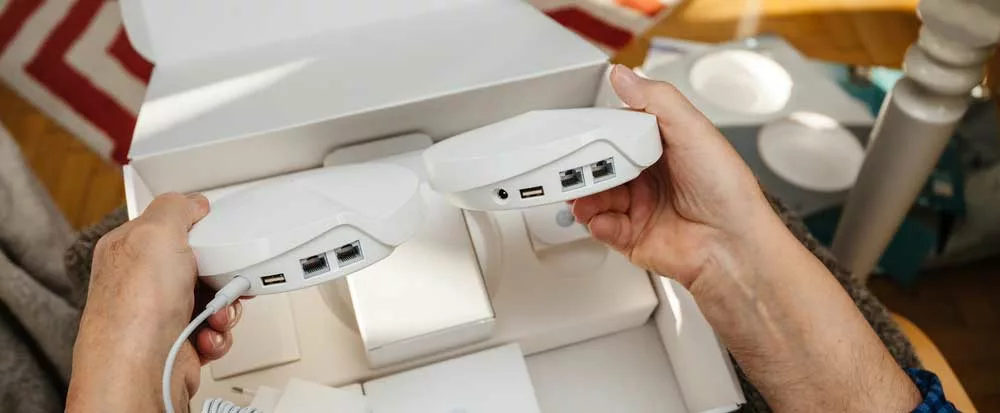About Ethernet cable adapter to walls, Today, our every activity is directly or indirectly connected to the internet, so high and consistent signal strength is a must.
Generally, an ethernet segment (twisted pair ethernet as most common) has an inherent limitation of distance, which is around 328 ft or 100 meters.
So, you will need an ethernet cable adapter for the wall if you want to extend your ethernet beyond this limited distance.
Let’s read about these powerline adapters to get an uninterrupted network in your home.
Table of Contents
- What is an ethernet cable adapter to walls?
- Ethernet cable adapter to walls vs. Ethernet over coax adapters: Pros and Cons
- Are mesh networks better than Ethernet cable adapters to walls?
- Conclusion:
What is an ethernet cable adapter to walls?
You may also know it by other names like powerline adapters, LAN extenders or network extenders.
Usually, LAN extenders have different physical media, including coaxial cables, fiber optic cables, copper wire or wireless, and varied transmission technologies.
An ethernet cable adapter to walls is one that uses your home’s electric wiring (copper wires) to transmit network signals.
These powerline adapters are based on the fact that copper wires not only transfer electricity but can also transmit data.
So with your home wiring, you can take an internet connection to any part of your home through electrical sockets.

Powerline adapters plugged into the wall
Ethernet cable adapter to walls vs. Ethernet over coax adapters: Pros and Cons
Ethernet over coax (MoCA)
The ethernet over coax adapters are alternatives to the ethernet cable adapters to walls.
Pros
Easy implementation: This adapter is a plug-and-play device that you can easily connect to the coax cable lines available in your home.
Having high bandwidth signal: With these adapters, you can get a minimum bandwidth of 175 Mbps which should be enough to play online games, stream two HD videos, and transfer images from PC to television.
High Security: As MoCA implements wired connections/coaxial cables, there are minimal chances of intruder interference.
High Compatibility: This adapter is highly compatible as it does not show any competition with other signals.
Cons
A limited number used: The no. of adapters in a network is defined as 16, and most houses need more than 4 of these adapters.
Expensive: MoCA adapters are expensive; one good quality adapter can cost around $100. However, at the same time, you must know that this cost is less than installing ethernet cables all over your home.
Connection
In this network implementation, you will need at least two MoCA adapters, coaxial and ethernet cables.
Step 1: Install the MoCA adapter in the room with an internet router. Connect the input ethernet port of the MoCA 1 to the router with an ethernet cable.
Step 2: Now, connect the coaxial output of the adapter to your home’s coaxial cable network.
Step 3: Install MoCA number 2 in another room with a computer. Connect MoCA number 2 coaxial port to your house walls’ coaxial cable.
Step 4: Connect your PC to the coaxial output port of the MoCA 2 adapter through an ethernet cable.
Caption: MoCA adapter setup
Image source: www.screenbeam.com
Ethernet over powerline
Ethernet over powerline technology is more accessible than Ethernet over Coax.
Pros
Save you money: As Ethernet over Powerline uses your home’s electrical cables, you need not use extra cables for data transfer.
Installing ethernet cables can be expensive, while powerlines save you money.
However, you must know that ethernet cabling comes at the top regarding the connection’s reliability and speed (optic fiber excluded).
It can match the highest rate of the Wi-Fi connection, i.e., 1300 Mbps.
Easy to use: Powerline adapters do not have allegiances, which means you can move them anywhere and use them for any device. After plugging in, they only take seconds to reconnect.
Easy implementation: You need not be tech-savvy to install powerline adapters as they are very simple to implement. Simply plug in and pair, and you are good to go.
Cons
Powerline adapters work only when both ends have the same circuit. If your home has multiple circuits due to extension or something else, you may face some issues.
These adapters do not work for garden offices, buildings, and large properties with 3-phase systems.
The working of the powerline adapters also depends on the electrical standards and practices of the particular location.
For example, powerline adapters are less effective in the USA than in the UK.
Powerline adapters face electrical interference. A powerline unit may suffer from interference from some devices.
This interference is temporary for some devices like microwaves and dryers, while some other appliances like freezers and fridges have consistent effects.
However, even after this interference, a powerline signal is faster than a weak Wi-Fi Signal.
They tend to lose speed. Irrespective of the circuit load, it will always prefer to provide electricity first, and thus you may experience a loss of speed with powerline adapters.
It’s pretty improbable that your internet connection runs solely on a powerline network. You must have at least had a wireless network from the router.
You can use powerline adapters to give extra strength to your existing network.
Powerline adapters are best for single-point networks but are not much effective for complete home networking.
A powerline kit may have numerous end units depending on the model.
The multiple units allow multiple connections with the router, but at the same time, having more units makes it less reliable.
Configuration options are limited. Their working depends on the socket’s location. Further, adapters from different brands don’t go together.
These adapters become ineffective with extension leads. So, if your TV is getting power line feed from a 20m extension feed, you will see it doesn’t work well.
You may experience significant speed loss even with short extension leads.
Low-frequency radio waves are emitted from these adapters. The electrical circuits can emit low-frequency radio waves due to the powerline adapters, which can be an issue for some radio enthusiasts.
Connection
Implementation of a powerline adapter includes the following steps:
Step 1: Plug the powerline adapters (take at least 2 in number) into the wall sockets.
Step 2: Connect the router to its one end and your device (PC, game console, or TV) to its other with the help of an ethernet cable.
Caption: Powerline adapter setup
Image source: www.hns-berks.co.uk
Are mesh networks better than Ethernet cable adapters to walls?
Both the mesh networks and these adapters help to extend internet connectivity.
The only difference is adapters use already-fitted electrical wires/coax cables to enhance connectivity, while mesh networks can make a Wi-Fi signal much more powerful with the help of multiple Access points (APs).
| Pros | Cons | Connection |
| If you are living in a rented house, you cannot drill holes to take cables to the first or second floor. You can easily take your network connection wirelessly anywhere in your home with a mesh network. A Wi-Fi mesh network can carry signals in the range of 6000 sq. ft. Installation and setup are flexible, as mobile apps make it easier to manage. It can extend your network wirelessly without pulling extra cables. Mesh network systems may look similar to Wi-Fi extenders, but the latter replaces your router’s network rather than extending it. So, Wi-Fi extenders use different network names for different parts of your home, but mesh Wi-Fi does not do that. | Mesh Wi-Fi systems are expensive when compared with Wi-Fi boosters. Although a mesh network uses different pods around the house to ensure a fast and reliable network, a Wi-Fi network is susceptible to interference from nearby wireless networks or other devices. Mesh Wi-Fi networks need a lot of configurations to set up. | Installation of the mesh network includes the following steps: Step 1: Connect the primary pod of the mesh network to the router through an ethernet cable. Step 2: There are some additional pods, too, which can be kept anywhere in the home. Connect the primary pod to all these additional pods to give a strong signal as and when required. Step 3: In case you have more than two access points, the mesh network will automatically detect the best connection. |

Conclusion:
So, you have read how you can take advantage of existing coaxial or electrical cables in your house to make your network powerful.
However, for best results, we always suggest you use high-quality cables to avoid any interference.
Cloom is a leading manufacturer of superior-quality coaxial, ethernet, electrical, and many other cables. We also offer customized solutions to meet every single requirement of our clients.
